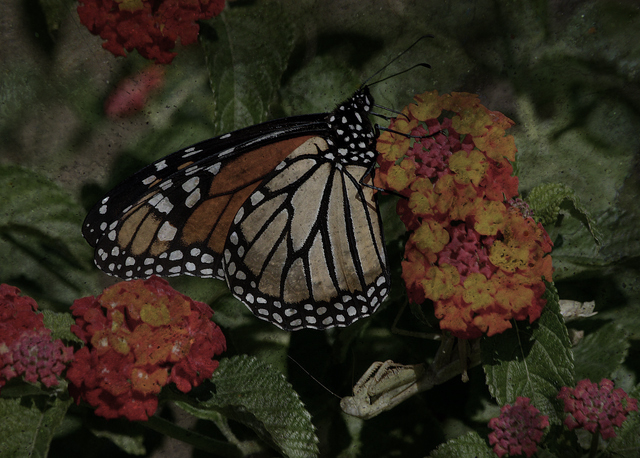
USDA researchers have identified the neonicotinoid insecticide clothianidin as a likely contributor to monarch butterfly declines in North America. The USDA research is published in the journal Science of Nature and was published online on April 3rd (Pecenka and Lundgren 2015).
Monarch butterfly populations (Danaus Plexippus) have declined precipitously in North America in the last twenty years. This decline has commonly been linked to loss of milkweeds (Asclepias species) from farmer’s fields. Monarch caterpillars are dependent on milkweeds. The ability of farmers to kill them with the Monsanto herbicide Roundup (glyphosate) has therefore led to this herbicide being considered as a major contributor to the decline of the monarch butterfly.
However, industrial farming methods include other known or potential causes of monarch disappearances. One of these is the known toxicity of Bt insecticides found in GMO crops. For instance, in 2006 pollen from Syngenta’s BT176 corn (no longer on the US market) was shown to have a lethal dose of 14 pollen grains towards caterpillars of European Swallowtail butterflies. Pollen from GMO crops falls on the milkweeds where monarchs feed and individual maize plants produce millions of pollen grains.
Neonicotinoids have been strongly implicated in pollinator declines worldwide. As shown by a report from a task force of the International Union of Nature Conservation based in Switzerland. Neonicotinoids, such as clothianidin (Bayer), are a particular hazard because, unlike most pesticides, they are soluble molecules. From soil or seed treatments they can reach nectar and are found in pollen. Neonicotinoids are now the most widely used pesticides in the world (Goulson 2013). Up to now there has been negligible research on the effects of neonicotinoids on butterflies and this new research is therefore the first to link neonicotinoids to the survival and reproduction of any butterfly.
In their experiments the USDA researchers showed that clothianidin can have effects on monarch caterpillars at doses as low as 1 part per billion. The effects seen in their experiments were on caterpillar size, caterpillar weight, and caterpillar survival. The lethal dose (LC50) they found to be 15 parts per billion. The caterpillars in their experiments were exposed to clothianidin-treated food for only 36hrs, however. The researchers therefore noted that in agricultural environments caterpillar exposure would likely be greater than in their experiments. Furthermore, that butterfly caterpillars would be exposed in nature to other pesticides, including other neonicotinoids.
In sampling experiments from agricultural areas in South Dakota the researchers found that milkweeds had on average over 1ppb clothianidin.
On this basis the USDA researchers concluded that “neonicotinoids could negatively affect larval monarch populations.”
This new report is therefore the first to link neonicotinoids to monarch butterfly survival and reproduction. Neonicotinoids are neurotoxins that are partially banned in the EU.
“These results are very worrisome, but it is also crucial not to get lost in the specifics of chemical toxicology and individual species declines” says Allison Wilson, Science Director of the Bioscience Resource Project, a non-profit public interest science organization. “Industrial agriculture is a lethal combination of methods that is causing the extinction of thousands of species worldwide. It is affecting birds, amphibians, bats and other pollinators besides butterflies. Many ecosystems are staring down the barrel.”
“The saddest irony is that, though industrial agriculture experts call their methods ‘scientific’, using toxins to kill pests runs contrary to all biological understanding, including the sciences of ecology, of evolution, and of complex systems. The proof of this is that the very best results in all of agriculture come from farming methods that reject all industrial inputs. Agribusiness would very much like that not to be known.”
“The best news is that there is a simple way to transfer to sustainable agricultural methods: remove the subsidies for industrial farming.”
References
Pecenka J and Lundgren J (2015) Non-target effects of clothianidin on monarch butterflies. Science and Nature 102: 19
IUCN Task Force (2014) Systemic pesticides pose global threat to biodiversity and ecosystem services
Goulson D. (2013) An overview of the environmental risks posed by neonicotinoid insecticides. Journal of Applied Ecology 50: 977–987.
Our most important fundraising appeal of the year
December is the most critical time of year for Truthout, because our nonprofit news is funded almost entirely by individual donations from readers like you. So before you navigate away, we ask that you take just a second to support Truthout with a tax-deductible donation.
This year is a little different. We are up against a far-reaching, wide-scale attack on press freedom coming from the Trump administration. 2025 was a year of frightening censorship, news industry corporate consolidation, and worsening financial conditions for progressive nonprofits across the board.
We can only resist Trump’s agenda by cultivating a strong base of support. The right-wing mediasphere is funded comfortably by billionaire owners and venture capitalist philanthropists. At Truthout, we have you.
We’ve set an ambitious target for our year-end campaign — a goal of $250,000 to keep up our fight against authoritarianism in 2026. Please take a meaningful action in this fight: make a one-time or monthly donation to Truthout before December 31. If you have the means, please dig deep.